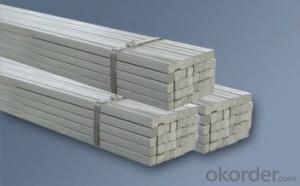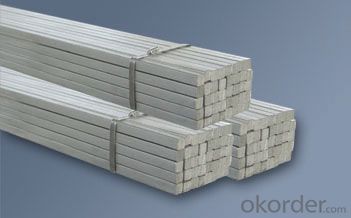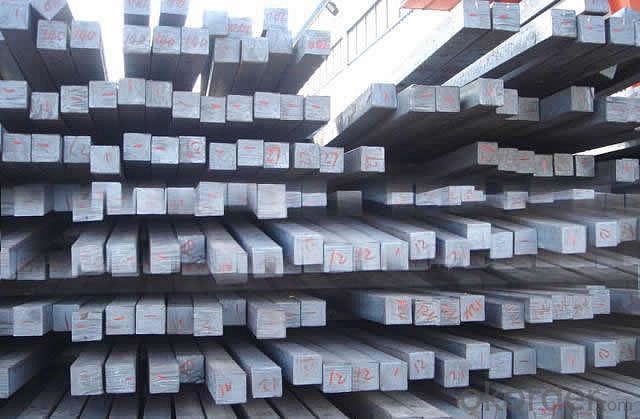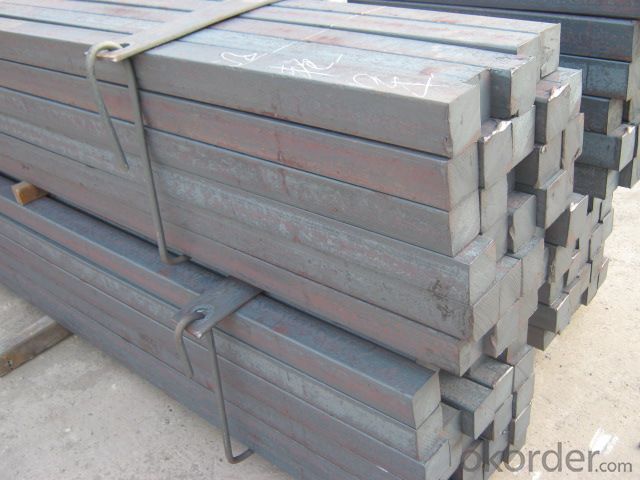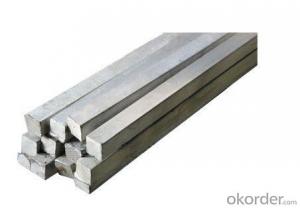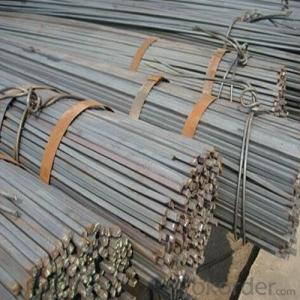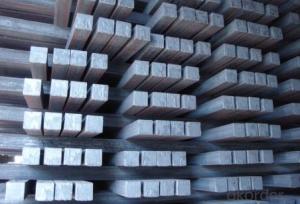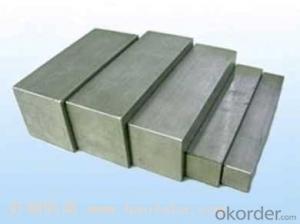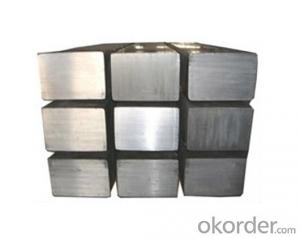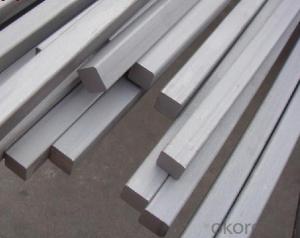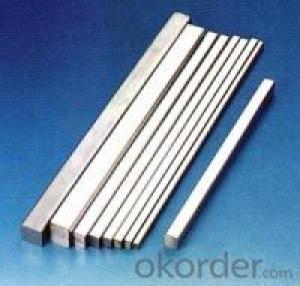Q345Cr High Quality Square Steel Bar
- Loading Port:
- Tianjin
- Payment Terms:
- TT OR LC
- Min Order Qty:
- 1000 m.t.
- Supply Capability:
- 100000 m.t./month
OKorder Service Pledge
OKorder Financial Service
You Might Also Like
Product Description:
Product Description:
In the production of steel products, steel is molded and reshaped with different machinery at different temperatures. One process is steel rolling, which involves metal stock passing through a pair of rolls. Rolling produces flat steel sheets of a specific thickness, and the process is classified according to the temperature at which the metal is rolled. If the temperature of the metal is above its recrystallization temperature, or the temperature at which the grain structure of the metal can be altered, then the process is termed as hot rolling. If the temperature of the metal is below its recrystallization temperature, the process is termed as cold rolling.
Like cold rolling, cold drawing is performed at room temperature, but instead of producing a flat object like a coke can, cold drawing makes steel into the form of a wire like the spokes of a wheel or a paper clip. To start the process, Steel is usual hammered and rolled so that it can be fit through a die; a tool that turns the steel mass into a wire. The room temperature steel is pulled through the die which reshapes it into a thinner shape while maintaining the same volume. It is similar to the idea of syrup flowing out of a bottle through a tube in that it changes shape but not volume, but instead of squeezing the metal, it is pulled out. In order to get the wire down to the right diameter, it usually requires more than one pass through different dies.
Colddrawn steel, steel covered carbon steel, excellent carbon steel, alloy structural steel, carbon tool steel, spring steel, bearing steel, tool steel, cold heading steel, free cutting steel, martensite stainless steel; products include all kinds of shapes round, square steel, hexagonal, flat steel and other conventional products, including various special-shaped steel products. In all types of colddrawn steel industry has been widely used, these areas include automotive, machine tools, furniture, standard parts, textile machinery, agricultural machinery, military industry and other industries.
The total assets of more than 40 million, as of the end of 2010 with fixed assets of 34 million, with 60 tons from 5 tons a chain drawing machine 10 sets, horizontal and inverted coiled wire drawing machine 5 sets, steel and plate production line of blasting, high-power ham stove, various straightening machine and cold rolling mill and other major equipment.
Usage/Applications
-The Square Bar is normally used as structure steel.
-Row material for other structure steel like steel angles, channels, I-beams, H-beams, etc…
Packaging & Delivery
-Packing Detail: The products can be packed in bundles by steel wires.
-Marks: We make tag marks and color marks. The tag marks with white background and red company logo will be tied up to each bundle of the products. The information is usually including basic information of products and company and other information requested by customers. As for color marks, we will paint both ends of bundles to make sure that it w
-Delivery Detail: 30~45 working days after receive buyer’s T.T. or L/C.
ill be more convenient for customers to distinguish them from other products.
- Q: Can a steel square be used for fence-building projects?
- Yes, a steel square can be used for fence-building projects. A steel square, also known as a framing square or a carpenter's square, is a versatile tool that is commonly used in construction and woodworking projects. It can help ensure accurate and square cuts, angles, and measurements, which are essential for building a sturdy and well-aligned fence. Whether you are constructing a wooden fence or a metal fence, a steel square can be used to lay out the fence posts, mark the angles for cuts, and check for squareness during the installation process. It is a valuable tool for any fence builder and can greatly assist in achieving precise and professional results.
- Q: How do you use a steel square to lay out a tenon joint?
- Achieving a flawless and secure tenon joint can be accomplished by following these steps with a steel square: 1. Start by gauging the width and thickness of both the tenon and mortise pieces. These measurements will determine the appropriate tenon size. 2. Indicate the shoulder line on the tenon piece. This demarcation signifies the boundary between the joint's tenon and shoulder. Utilize the steel square's straight edge to ensure an impeccably straight line. 3. Measure the length of the tenon on the tenon piece. This measurement will dictate the mortise's required depth on the mortise piece. Employ the steel square to mark this measurement on the tenon piece. 4. Once the shoulder line and tenon length are marked, position the steel square against the tenon piece's edge, aligning it with the shoulder line. This alignment guarantees a perfect right angle cut for the tenon in relation to the shoulder line. 5. Utilize the steel square to designate the tenon's sides on the tenon piece. Simply place the steel square against the tenon piece's edge, aligning it with the shoulder line, and mark the tenon's width on both sides. 6. Subsequently, transfer the marks from the tenon piece to the mortise piece. Align the tenon piece with the mortise piece, ensuring the shoulder line coincides with the desired location, and use the steel square to transfer the width and length marks onto the mortise piece. 7. Lastly, employ a saw to cut along the marked lines on both the tenon and mortise pieces. The outcome should yield a tenon joint that is impeccably sized and aligned. By utilizing a steel square to establish a tenon joint, you can guarantee precise measurements and accurate angles, resulting in a robust and perfectly fitting joint. Remember to consistently verify your measurements and utilize sharp tools for optimal results.
- Q: How do you use a steel square to mark out parallel lines on uneven surfaces?
- To use a steel square to mark out parallel lines on uneven surfaces, you would first place the square on the surface with one edge aligned with the desired starting point of the parallel lines. Then, using a pencil or scribe, mark a line along the edge of the square. Next, move the square along the surface, aligning the marked line with the opposite edge of the square, and mark another line. Repeat this process until you have marked out all the parallel lines you need. The steel square helps maintain the parallel alignment despite the unevenness of the surface.
- Q: What are the different parts of a steel square?
- A steel square, also known as a framing square or carpenter's square, consists of several parts that are essential for its functionality. The main components of a steel square include: 1. Blade: The blade is the long, flat metal surface on one side of the square. It is usually marked with measurements and angles, allowing for precise measurements and layout work. 2. Tongue: The tongue is a shorter section of metal located at the end of the blade. It is perpendicular to the blade and is typically used for marking and measuring short distances. 3. Heel: The heel is the wider end of the steel square, opposite to the tongue. It provides stability and acts as a reference point for making square cuts and angles. 4. Face: The face is the flat part of the square that is perpendicular to the blade and tongue. It is commonly utilized for drawing straight lines and checking the squareness of corners. 5. Fence: The fence is a raised edge along the face of the square. It helps in holding the square firmly against the workpiece, ensuring accurate measurements and straight lines. 6. Graduations: Graduations are markings or measurements found on the blade and face of the square. They allow for precise measurements of distances, angles, and cuts. 7. Squaring and Angle Scales: These scales are usually located on the face of the square and are used for measuring angles other than 90 degrees. They come in handy for marking angles, bevels, and complex cuts. 8. Rafter Tables: Some steel squares feature rafter tables, which are tables or charts engraved on the blade. These tables provide information and calculations for various roof framing applications, such as determining rafter lengths and angles. Overall, the different parts of a steel square work together to provide accuracy, stability, and versatility for various carpentry and layout tasks.
- Q: What are the dimensions of a steel square?
- The dimensions of a steel square can vary depending on its intended use. However, in general, a steel square typically has two equal sides that form a right angle. These sides can be anywhere from a few inches to several feet in length. The most common size for a steel square used in construction or woodworking is 24 inches by 16 inches, with a thickness of 1/8 inch. However, smaller sizes, such as 6 inches by 4 inches, or larger sizes, such as 48 inches by 32 inches, can also be found. Ultimately, the dimensions of a steel square will depend on the specific needs and requirements of the project at hand.
- Q: Can a steel square be used for checking the squareness of shelving units?
- Yes, a steel square can be used for checking the squareness of shelving units. A steel square is a reliable tool commonly used in carpentry and woodworking to determine the squareness of corners and angles. It has a 90-degree angle and is made of durable steel, ensuring accurate measurements. By placing the steel square against the corners of a shelving unit, one can easily check if the corners are perfectly square or not. This is important for ensuring stability and proper alignment of the shelving unit, especially if it will be loaded with heavy items.
- Q: Can a steel square be used for tile corner layout?
- Yes, a steel square can be used for tile corner layout. A steel square, also known as a framing square or carpenter's square, is a versatile tool that can be used for a variety of layout tasks, including tile corner layout. The right-angle shape of the steel square makes it ideal for ensuring precise and accurate corners when laying tiles. By placing the steel square against the corner of the tiles, you can make sure they are properly aligned and square to each other. This is particularly useful when working with large tiles or when creating intricate tile patterns where precise corner alignment is crucial.
- Q: How do you use a steel square to find the length of a board?
- To use a steel square to find the length of a board, follow these steps: 1. Begin by placing the steel square against one end of the board, ensuring that it is aligned properly with the edge. 2. Hold the steel square firmly in place, making sure it doesn't move during the measurements. 3. Look at the long side of the steel square, which is often referred to as the blade. It will have measurements marked on it. 4. Locate the inch markings on the blade and find the line that corresponds to the width of the board. For example, if the board is 6 inches wide, find the line labeled "6". 5. Once you have found the correct line, look at the short side of the steel square, called the tongue. It will have measurements marked on it as well. 6. Align the tongue with the edge of the board, ensuring that it is flush against the side. 7. While keeping the steel square and tongue in place against the board, extend the blade along the length of the board. 8. Now, observe the measurement marked on the blade where it aligns with the opposite end of the board. This measurement indicates the length of the board. 9. Take note of the measurement or use a pencil to mark it on the board for future reference. By using a steel square in this manner, you can accurately determine the length of a board, providing you with the necessary information for your woodworking or construction project.
- Q: How to make the steel arc
- If reinforced by 1. fold 2. arc bending machine flame cutting machine 4. fold 3. baking arc building arc roll can be solid steel grip bending machine processing.
- Q: How do you use a steel square for marking roof gable angles?
- To use a steel square for marking roof gable angles, follow these steps: 1. Start by determining the desired pitch or slope for the gable. This is typically specified in terms of rise over run, such as 6/12 (for a 6-inch rise over a 12-inch run) or 8/12. 2. Next, position the steel square on the gable rafter. The long side of the square, called the blade, should align with the edge of the rafter, while the short side, called the tongue, should rest against the top of the rafter. 3. Adjust the steel square until the desired pitch or slope aligns with the edge of the rafter. You can do this by sliding the square up or down the rafter until the markings on the square indicate the desired pitch. 4. Once the steel square is properly positioned, use a pencil or marker to mark the angle on the rafter. You can do this by tracing along the tongue of the square or using a straight edge to extend the lines from the markings on the square. 5. Repeat this process for each gable rafter, ensuring that all angles are marked consistently. By using a steel square in this manner, you can accurately mark the angles for roof gables, ensuring that the roof is properly pitched and aligned. Remember to double-check your measurements and markings before making any cuts or adjustments to the rafters.
Send your message to us
Q345Cr High Quality Square Steel Bar
- Loading Port:
- Tianjin
- Payment Terms:
- TT OR LC
- Min Order Qty:
- 1000 m.t.
- Supply Capability:
- 100000 m.t./month
OKorder Service Pledge
OKorder Financial Service
Similar products
Hot products
Hot Searches
Related keywords
